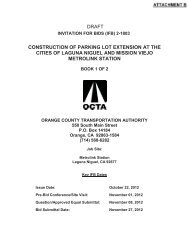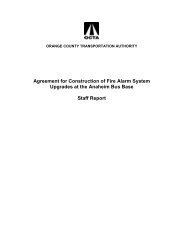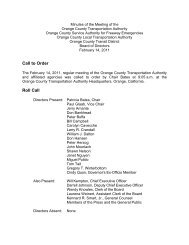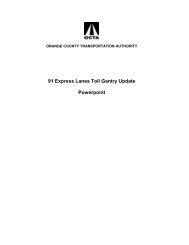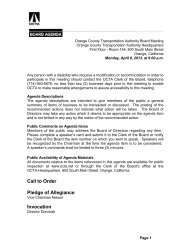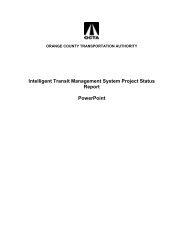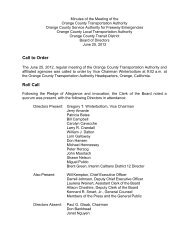- Page 1 and 2: ORANGE COUNTY TRANSPORTATION AUTHOR
- Page 3 and 4: TABLE OF CONTENTS EXECUTIVE SUMMARY
- Page 5 and 6: Figure 48: Orange County Potential
- Page 7 and 8: RHNA Regional Housing Needs Assessm
- Page 9 and 10: Because there is an indisputable in
- Page 11 and 12: INTRODUCTION BACKGROUND SB 375 was
- Page 13 and 14: migration into the region, populati
- Page 15 and 16: enhanced subregional public outreac
- Page 18 and 19: CHAPTER 1: POPULATION, HOUSING, AND
- Page 22 and 23: Orange County Sustainable Communiti
- Page 24 and 25: Orange County Sustainable Communiti
- Page 26 and 27: Orange County Sustainable Communiti
- Page 28 and 29: patterns of use will foster efficie
- Page 30 and 31: Orange County Sustainable Communiti
- Page 32 and 33: Orange County Sustainable Communiti
- Page 34 and 35: HOUSING In 2008, Orange County had
- Page 36 and 37: Figure 15 shows that between 2005 a
- Page 38 and 39: Orange County Sustainable Communiti
- Page 40 and 41: Orange County Sustainable Communiti
- Page 42 and 43: Orange County Sustainable Communiti
- Page 44 and 45: Orange County Sustainable Communiti
- Page 46 and 47: Orange County Sustainable Communiti
- Page 48 and 49: Orange County Sustainable Communiti
- Page 50 and 51: Orange County Sustainable Communiti
- Page 52 and 53: HOUSING CONCLUSION Orange County’
- Page 54 and 55: Orange County Sustainable Communiti
- Page 56 and 57: Orange County Sustainable Communiti
- Page 58 and 59: Orange County Sustainable Communiti
- Page 60 and 61: Orange County Sustainable Communiti
- Page 62 and 63: Orange County Sustainable Communiti
- Page 64 and 65: Orange County Sustainable Communiti
- Page 66 and 67: Orange County Sustainable Communiti
- Page 68 and 69: that will reduce regional GHG emiss
- Page 70 and 71:
CHAPTER 2: EXISTING TRANSPORTATION
- Page 72 and 73:
ARTERIALS AND LOCAL ROADS The freew
- Page 74 and 75:
NEWLAND ELLIS GARFIELD YORKTOWN ADA
- Page 76 and 77:
While there have been extensive inv
- Page 78 and 79:
NEWLAND ELLIS GARFIELD YORKTOWN ADA
- Page 80 and 81:
CHAPTER 3: STRATEGIES TO REDUCE GRE
- Page 82 and 83:
address and monitor transportation
- Page 84 and 85:
development occurs, it creates an o
- Page 86 and 87:
OC SCS Land Use Strategy: Promote l
- Page 88 and 89:
LOS ANGELES Orange County Sustainab
- Page 90 and 91:
enefiting OCTA express bus services
- Page 92 and 93:
ELECTRIC 605 SEAL BEACH Arterial Hi
- Page 94 and 95:
South County and Euclid Avenue in N
- Page 96 and 97:
pavement that control traffic signa
- Page 98 and 99:
Target High-Demand Corridors and In
- Page 100 and 101:
LOS ANGELES CYPRESS LOS ALAMITOS Or
- Page 102 and 103:
LOS ANGELES To MTA Blue Line Willow
- Page 104 and 105:
manage travel demand through the us
- Page 106 and 107:
Bicycle Programs Bicycles can be us
- Page 108 and 109:
the employer and the employee. Oran
- Page 110 and 111:
Objective 8: Complete an agreement
- Page 112 and 113:
Implementation of the M2 EAP projec
- Page 114 and 115:
Imperial Highway interchange. Add a
- Page 116 and 117:
DORY LOS ANGELES SEAL BEACH LINCOLN
- Page 118 and 119:
LOS ANGELES Orange County Sustainab
- Page 120 and 121:
Alternate Fuel Alternate Modes of
- Page 122 and 123:
improvements to reduce or eliminate
- Page 124 and 125:
Anaheim Platinum Triangle Project L
- Page 126 and 127:
Project Location City of Tustin spa
- Page 128 and 129:
Robinson Ranch Road Traffic Calming
- Page 130 and 131:
Beach Boulevard Signal Synchronizat
- Page 132 and 133:
Transportation Corridor Agencies Ha
- Page 134 and 135:
South Brea Lofts Project Location C
- Page 136 and 137:
Ladera Ranch and Rancho Mission Vie
- Page 138 and 139:
Southeasterly Unincorporated County
- Page 140 and 141:
Project Location City of Aliso Viej
- Page 142 and 143:
they will help meet the federal air
- Page 144 and 145:
10 East Los Angeles Downey 105 Long
- Page 146 and 147:
0 East Los Angeles Downey 105 Long
- Page 148 and 149:
The CPAD version used for Figure 61
- Page 150 and 151:
0 East Los Angeles Downey 105 19 Lo
- Page 152 and 153:
Riverside Fairy Shrimp: 5/12/2005
- Page 154 and 155:
APPENDICES 144
- Page 156 and 157:
September 20, 2010 Ms. Mary Nichols
- Page 158 and 159:
description of what is required for
- Page 160 and 161:
Business Groups: Staff met several
- Page 162 and 163:
1.7 million hours reduction in dail
- Page 164 and 165:
APPENDIX B CREATING ORANGE COUNTY
- Page 166 and 167:
in the development of the OC SCS (e
- Page 168 and 169:
1 2 3 4 5 6 7 8 9 10 11 12 13 14 15
- Page 170 and 171:
1 2 3 4 5 6 7 8 9 10 11 12 13 14 15
- Page 172 and 173:
1 2 3 4 5 6 7 8 9 10 11 12 13 14 15
- Page 174 and 175:
1 2 3 4 5 6 7 8 9 10 11 12 13 14 15
- Page 176 and 177:
flexibility and responsibility in d
- Page 178 and 179:
encouraged to capture, further deve
- Page 180 and 181:
(ii.) May include an alternative de
- Page 182 and 183:
(7) Timing An overview schedule of
- Page 184 and 185:
In addition to modeling tools which
- Page 186 and 187:
Other tools currently maintained by
- Page 188 and 189:
APPENDIX D ORANGE COUNTY PROJECTION
- Page 190 and 191:
themselves may have developed. Stan
- Page 192 and 193:
APPENDIX E LRTP YEAR 2035 PREFERRED
- Page 194 and 195:
Detailed Year 2035 Baseline Project
- Page 196 and 197:
Detailed Year 2035 Baseline Project
- Page 198 and 199:
Detailed Year 2035 Preferred Plan P
- Page 200 and 201:
Detailed Year 2035 Baseline Project
- Page 202 and 203:
Detailed Year 2035 Baseline Project
- Page 204 and 205:
Detailed Year 2035 Preferred Plan P
- Page 206 and 207:
Detailed Year 2035 Preferred Plan P
- Page 208 and 209:
Detailed Year 2035 Baseline Project
- Page 210 and 211:
Detailed Year 2035 Baseline Project
- Page 212 and 213:
Detailed Year 2035 Baseline Project
- Page 214 and 215:
Detailed Year 2035 Baseline Project
- Page 216 and 217:
Detailed Year 2035 Baseline Project
- Page 218 and 219:
Detailed Year 2035 Preferred Plan P
- Page 220 and 221:
Best Management Practices List for
- Page 222 and 223:
Best Management Practices List for
- Page 224 and 225:
Best Management Practices List for
- Page 226 and 227:
San Joaquin Hills Foothill/Eastern
- Page 228 and 229:
Mr. Scott Martin February 10, 2011
- Page 230 and 231:
February 18, 2011 OC School Distric
- Page 232 and 233:
February 18, 2011 OC School Distric
- Page 234 and 235:
February 18, 2011 OC School Distric
- Page 236 and 237:
CEQA Streamlining: Existing Land Us
- Page 238 and 239:
Endangered Species and Plants revie
- Page 240 and 241:
Appendix H for a sample of the Data
- Page 242 and 243:
Please review and submit comments b
- Page 244 and 245:
Table of Contents Page | ii Introdu
- Page 246 and 247:
Page | 2 For more information or to
- Page 248 and 249:
Appendix 1: SCAG General Plan Code
- Page 250 and 251:
Page | 6 Zoning- FOR JURISDICTION R
- Page 252 and 253:
Page | 8 2008 Existing land use- FO
- Page 254 and 255:
Transportation, Communications, and
- Page 256 and 257:
Endangered Species and Plants Page
- Page 258 and 259:
Flood Areas Page | 14 The flood are
- Page 260 and 261:
Natural Community & Habitat Conserv
- Page 262 and 263:
Open Space and Park Page | 18 For R
- Page 264 and 265:
Page | 20 Open Space- FOR JURISDICT
- Page 266 and 267:
URBAN AND BUILT-UP LAND (D) Page |
- Page 268 and 269:
Transit Priority Project Page | 24
- Page 270 and 271:
Page | 26 removal of any species pr
- Page 272 and 273:
Page | 28
- Page 274 and 275:
Page | 30
- Page 276 and 277:
Geographical boundaries Page | 32 S
- Page 278 and 279:
Page | 34 Census Tract Boundary- FO
- Page 280 and 281:
Housing + Transportation Affordabil
- Page 282 and 283:
Page | 38 Transportation and Housin
- Page 284:
APPENDIX I JURISDICTION GENERAL PLA



